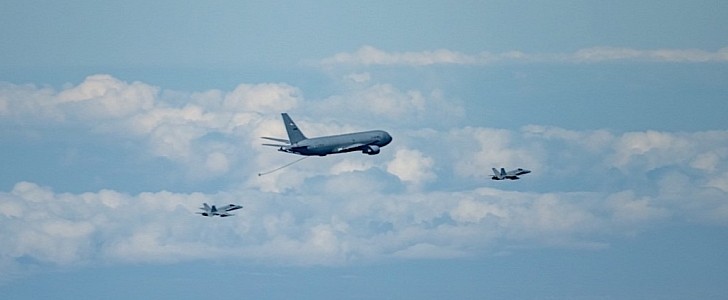After years and years of practice, aerial refueling seems to have become a second nature for American pilots, and, thanks to the rapid expansion of aerial refueling capabilities, for quite a lot of them. As far as foreign pilots are concerned, that’s not really the case, and they do need some practice.
With over 600 tanker aircraft in operation, the largest fleet of its kind on the planet (the rest of the world combined has less than half that), the U.S. is undoubtedly the country that uses this means of keeping its planes in the air the most.
The nation is beginning to share fuel in the sky, though, and we got a taste of that in mid-April, when a KC-46A Pegasus became the first tanker of its kind to refuel an “international receiver,” as the U.S. Air Force (USAF) says.
That international receiver is the EF-18 Hornet, deployed with the Spanish Air Force (SAF). As it customary in the industry, the “E” in the name stands for Espana, the name of the country using this variant of the McDonnell Douglas (now Boeing) machine.
The refueling operation took place in the skies over the Moron Air Base, during the tanker’s first Employment Concept Exercise. The exercise was meant to pave the way “for stronger interoperability with allies and partners.”
“The Pegasus is now cleared to support nearly 85 percent of joint force receivers requesting air refueling from U.S. Transportation Command,” said in a statement Brig. Gen. Ryan Samuelson, Air Mobility Command’s KC-46A Cross Functional Team lead.
“While the ICR brought on KC-46 mission capabilities, the ECE will now operationalize those capabilities across a spectrum of mission scenarios.”
Derived from the 767 jet airliner, the Pegasus is powered by two Pratt & Whitney engines with an output of 62,000 lbs of thrust, and can carry 212,299 pounds (96,297 kg) of fuel.
The nation is beginning to share fuel in the sky, though, and we got a taste of that in mid-April, when a KC-46A Pegasus became the first tanker of its kind to refuel an “international receiver,” as the U.S. Air Force (USAF) says.
That international receiver is the EF-18 Hornet, deployed with the Spanish Air Force (SAF). As it customary in the industry, the “E” in the name stands for Espana, the name of the country using this variant of the McDonnell Douglas (now Boeing) machine.
The refueling operation took place in the skies over the Moron Air Base, during the tanker’s first Employment Concept Exercise. The exercise was meant to pave the way “for stronger interoperability with allies and partners.”
“The Pegasus is now cleared to support nearly 85 percent of joint force receivers requesting air refueling from U.S. Transportation Command,” said in a statement Brig. Gen. Ryan Samuelson, Air Mobility Command’s KC-46A Cross Functional Team lead.
“While the ICR brought on KC-46 mission capabilities, the ECE will now operationalize those capabilities across a spectrum of mission scenarios.”
Derived from the 767 jet airliner, the Pegasus is powered by two Pratt & Whitney engines with an output of 62,000 lbs of thrust, and can carry 212,299 pounds (96,297 kg) of fuel.

































